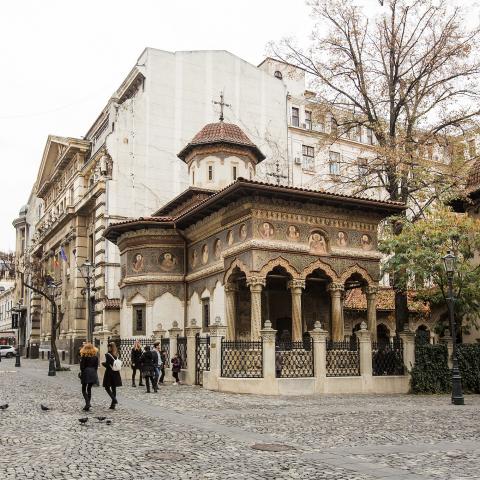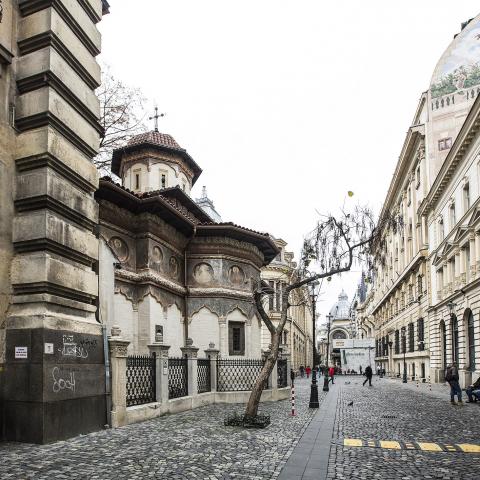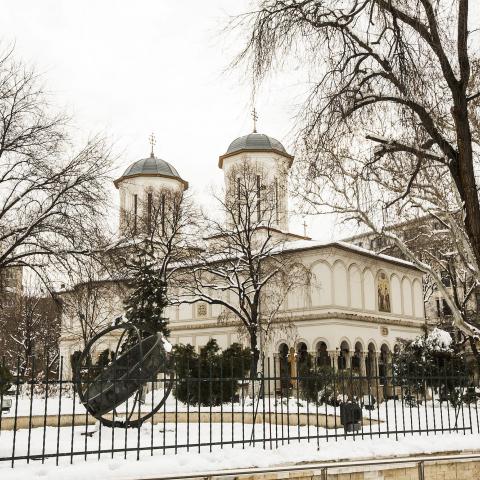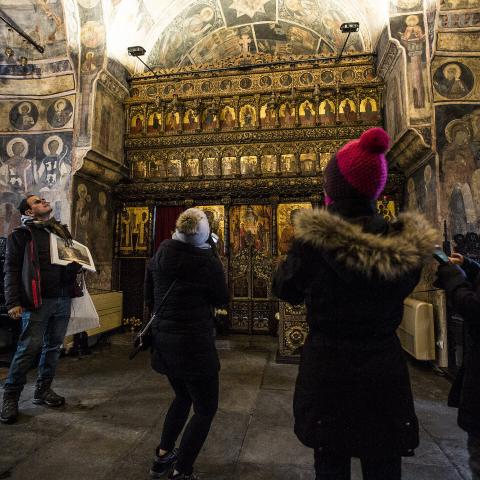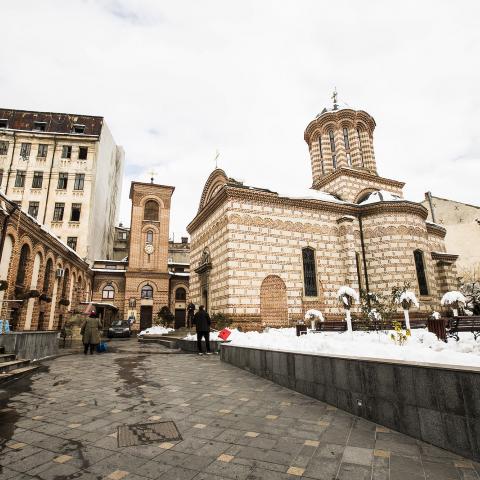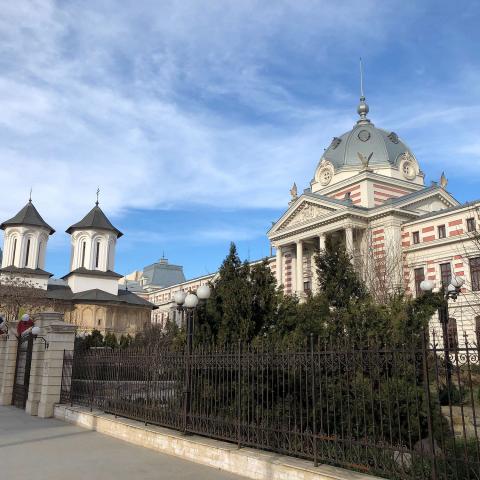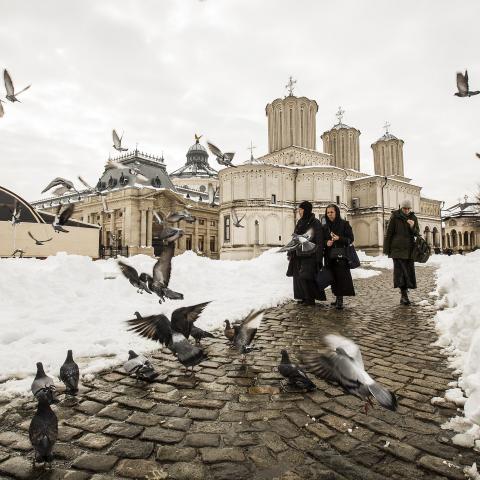“Destination: Bucharest” - A tour of the city’s churches

After the urban transformations undertaken during the last years of communism, the city’s churches were among the most affected. Demolished, relocated and hidden in between blocks of flats, these managed to survive however, taking further a rich patrimony of religious art and architecture. We go on a tour of several of the city’s Orthodox churches and discover centuries of history that gather active communities.
First stop: Colțea Church, near Universitate Square. Constable Mihail Cantacuzino built it between 1695 and 1698, on the place of a wooden church dating back to 1641. It is considered a representative monument of the Brâncovenesc era, combining decorative techniques of the local tradition with oriental, Baroque and Late Renaissance influences. The exterior fresco is attributed to Pârvu Mutu, a muralist and church painter who worked on several ensembles, many of them commissioned by the Cantacuzino family.
The church is the only element reminiscent of the monastery - hospital “Sfinții Trei Ierarhi” (Three Holy Hierarchs), the ensemble established by Mihail Cantacuzino, whose statue can be seen nearby, inside the courtyard of the Colțea Hospital. In time, the church was repaired and refurbished on several occasions.
At the entrance, we find the stone portal, richly decorated. On the frontispiece, we can spot the Cantacuzinos’ emblem: the double-headed eagle. The wooden door is adorned with zoomorphic and floral motifs, and inside we find the painting redone in 1871 by Gheorghe Tattarescu. The church’s founders, Mihail Cantacuzino and his wife, Maria (Marga), are also portrayed inside. The church preserves the original iconostasis, valuable icons and many other furniture times dating back to the time of its founders, richly and detailed ornamented.
It is Wednesday morning, but we already find several people inside the church. One lady approaches as well, crosses herself before entering the church’s portal, and again, at the church entrance. She keeps silent in a prayer for a few moments then heads towards the corner where candles and icons are sold and asks for “chrism and incense.” On a table facing the opposite wall we spot a flyer announcing this year’s offer of pilgrimages, which includes destinations like Italy or themed trips – Romanian Churches in Europe.
We leave behind Colțea Church and walk further on I.C. Brătianu boulevard to reach Sfântul Gheorghe Nou Church, the last known undertaking of prince Constantin Brâncoveanu. The church, close to the Old Town, sits in a small park, where there is also a statue of prince Constantin Brâncoveanu and the Kilometer Zero Monument.
This was conceived by architects Horia Creangă and Ștefan Niculescu and designed by sculptor Constantin Baraschi in 1938. It is a wind rose, in whose rays the names of the historical Romanian provinces are inscribed. The rose sits in a small basin, on the margins of which the names of several cities in Romania are written. Among the cities listed are Chișinău or cities that are today part of Bulgaria, testimony to the monument’s age and the country’s borders at the time of its making.
On one side of the church we find the places for lighting candles, labeled separately “The Living” and “The Asleep.” A lady who has just lit a candle puts her sunglasses back on and departs, passing past the two old plane trees standing in front of the church. Two small plaques let the public know that these are protected trees.
We approach the entrance as the sound system broadcasts a religious hymn. On the church’s porch, a fragment from the poem „The Prayer of a Dacian”, inscribed on a wall. The poem was written by Mihai Eminescu, whose funeral service was held at this church. Another thing that catches our eye immediately are the fresh colors of the frescoes, from the portico to the inside, the result of a restoration process started in 2008.
The church is one of the oldest in the city. Its construction started in 1705 and, at the time, the edifice was part of a larger ensemble. Pârvu Mutu also worked here as a painter. In time, it went through several earthquakes and fires. For instance, an earthquake in 1802 destroyed its vaults and domes and it was later redone without the latter. After the Great Fire in 1847, architect Xavier Villacrosse, who lends his name to the passage on Calea Victoriei, designed a new project for the church, hence the name of Sfântul Gheorghe Nou (The New St. George). The architecture of the edifice replicates the pattern of the church erected by ruler Neagoe Basarab in Curtea de Argeş. The church has a porch with seven front arches and three ones on the sides, resting on columns with ornate capitals. The narthex is square shaped, with four columns supporting a central dome.
The church houses the tomb of prince Constantin Brâncoveanu, beheaded, together with his four sons and advisor Ianache Văcărescu, on August 15, 1714, in Constantinople. The prince was canonized by the Romanian Orthodox Church in 1992, alongside the five.
Inside, we hear the same religious hymn. It is around 11:00 AM; there are 15 people inside and the flux of visitors and believers is continuous. They go from the right to the left to pray at and kiss the icons. One lady with a medical mask on her face, walking with a bit of difficulty, enters the church carrying the envelope of an X-ray performed at a private medical center. A couple- father and son – also walk round the inside of the church, followed by a mother with a small child in a stroller. A young lady who could be a student also joins the queue. She balances her bag, hanging from a chains strap, with one hand and crosses herself with the other. Everyone spends more or less time praying in front of their favorite icon.
In a corner, a table is used to write notes with the names of those who are to be mentioned in prayers. A generous space is taken up by a glass display exhibiting various items that can be purchased: icons, prayer books, prayer books for children, CDs with religious music or prayers.
When exiting the church, we spot a couple on the sidewalk where the tram station is, trying to capture a shot of the statue of Constantin Brâncoveanu and the church. From behind, from the Cocor store, a man comes running. He holds a donut in one hand and is in a rush to catch the tram that is just making the round in the station. He crosses himself swiftly before hurrying up for the tram.
We walk past the Cocor store, cross the Unirii Park, go past the Orthodox Bookstore and the Misionarul (The Missionary) pastry shop and climb the Mitropoliei Hill to reach the Patriarchal Cathedral, a place of yearly pilgrimage for thousands of believers.
The ensemble of buildings at the top of the hill also includes the patriarchal residence and the Patriarchy Palace, a former headquarters of the Chamber of Deputies.
The building of the Patriarchal Palace was built by the Romanian state at the beginning of the 20th century, on the spot of a former hall of the Deputies Gathering on Mitropoliei Hill. Here, on January 24 1859, the elective gathering of Wallachia voted to elect Alexandru Ioan Cuza as ruler of Wallachia, thus enacting the union of the province with Moldova. The palace was built in 1907 on the plans of architect Dimitrie Maimarolu. It underwent various changes in time, most importantly the redoing of its dome, which fell at the November 1940 earthquake. The building served as the headquarters of the Chamber of Deputies until 1997. The palace can be visited for free, from Monday to Friday. But not today. An activity is taking place, we are told. We are left with the option of admiring it from the outside, the same thing that a couple who stopped to take some shots does. Two Asian tourists also take pictures in the small court surrounded by the buildings of the ensemble, before entering the cathedral.
The courtyard is quiet, only the wind and very little of the traffic can be heard. A lady carrying a shopping trolley walks past the entrance of the church; she has just lit a candle in the dedicated space on the left side. A nun carrying a large bag on her shoulder crosses the yard, while a mother and her child get ready to enter the church as well.
The ensemble dates back to the middle of the 17th century, when Constantin Șerban Basarab, a ruler of Wallachia, erected a monastery here, in 1656. It was painted for the first time in 1665, during the reign of Radu Leon (1664-1669), who also decided in 1668 that it should become a metropolitan residence. The current painting belongs to Dimitrie Belizarie, and dates from 1932-1935.
The church, which became a patriarchal cathedral in 1925, was built after the model of the Curtea de Argeș Moanstery, established by ruler Neagoe Basarab. A restoration process carried out between 1960 and 1962 gave back its initial look. On the porch, at the entrance, the icon of Saints Constantin and Elena, painted in 1665, can be found.
Inside the church, next to the entrance, someone is getting a bottle filled with water – we assume holy water – from the plastic cauldron near the door. Also on the right side we find the tombstones of four patriarchs of the Romanian Orthodox Church - Miron Cristea, Nicodim Munteanu, Justin Moisescu și Teoctist Arăpașu – but also a list of bishops of Wallachia.
Plenty of people are going in and out of the church, many coming to pray at the relics of St Dimitrie the New, brought from the village of Basarabi, in 1774, by archbishop Grigorie II (1760-1787). The saint is considered the spiritual patron of Bucharest and his celebration, on October 27, occasions a pilgrimage of thousands of believers who queue on the Mitropoliei Hill.
As we get ready to leave, we realize the Mitropoliei Hill is one of the spots in the city that offers a very good view of the Parliament Palace and the nearby People’s Redemption Cathedral. The idea of a monumental cathedral dates back to the period after the Independence War of 1877-1878. Kings Carol I and Ferdinand I supported the project at the time. The construction started in 2011 and the altar of the cathedral, dedicated to St Andrei, the patron saint of Romania, was consecrated in November 2018.
The building of the cathedral is taller than that of the Parliament Palace, the mega-construction that so many tourists visit, and can welcome 5,000 visitors at once. The big bell, weighing 25 tons, was lifted to a height of over 60 meters with a special crane. The cathedral was open to the public when the altar was consecrated. It was also open for the visit of Pope Francis to Bucharest in 2019. In 1999 and 2002, Pope John Paul II offered financial help for building the cathedral. Until the inauguration, with works still underway, religious services are held at the chapel built nearby in 2011.
We descend the Mitropoliei Hill, cross one of the bridges across Dâmbovița river, enter Căldărari street, past Manuc’s Inn, and we reach the St Anton Church at the Old Princely court, easily recognizable by the alternating stripes of apparent brick and plaster. It is considered the oldest church in the city still retaining its original shape. It served as a chapel for the Princely Court, located nearby but currently not accessible to visitors because of works at the archeological site. The architecture of the church takes after the one of Cozia Monastery. The tomb of Wallachian ruler Mircea Ciobanul, who passed away in 1599, can be found inside the church. Furthermore, the church preserves the inscription laid by Șerban Cantacuzino in 1715, when the painting of the edifice was redone. Also then, a stone framing, sculpted in the Renaissance style, was added at the entrance.
We find the church filled with people, tourists and believers. On one side of the church, people are busy writing notes for prayers. The priest is taking confessions, while a choir can be heard singing in the background.
We stop for a few moments to admire the interior, before heading for another church in the Old Town – Stavropoleos Church, which stands on the street of the same name. It was built in 1724, during the reign of Nicolae Mavrocordat, in an area that also included an inn, which no longer exists today. The church was built in the Brâncovenesc style while the yard and the lapidarium are the outcome of a restoration project undertaken by architect Ion Mincu in 1904. The edifices are built in the neo-Romanian style, with arches and stone columns inspired by those of the church’s porch. They were erected on the spot of the former Stavropoleos Inn, demolished at the end of the 19th century.
A restoration process was started in 1995 and in 2008 the ensemble became a monastery again. At the Sunday service or those held on important religious celebrations, the church can hardly fit the numerous community that attends here. It is also one of the most visited sites in the city, something confirmed during this mid-week day.
As soon as we arrive we spot two tourist couples taking the last shots before leaving for another site, and another going in to visit the church. We stop in the courtyard, where the proverbial quietness of the place envelops us. A nun is cleaning up the area – she sweeps, gathers the rubber carpet sitting at the basis of the church’s stairs, cleans it up and puts it back in its place.
We enter the church and discover that there is no one inside, except the lady who tends to the area from where candles can be purchased. She turns the lights on to allow us to better see the interior – the architecture, painting and furniture items. The restoration project of the place also received an award in 1995 for the preservation of the European architectural patrimony.
From Stavropoleos we reach Calea Victoriei and head towards Kretzulescu Church. Today the church sits in a downtown area of the city, one of the most visited by tourists, but at the time it was erected, in between 1720 and 1722, it stood in the area of the northern barrier of the city, at Puțul cu zale, one of the springs that supplied drinkable water to Bucharest residents. The church was erected at the wish of chancellor Iordache Kretzulescu and his wife, Safta, one of the daughters of Constantin Brâncoveanu.
It is a monument typical of the Brâncovenesc style, and the entrance to the church is made through an open porch, flanked by stone columns. Here, the original painting and inscription can be seen, above the door. In time, the edifice underwent several changes and restoration as it was damaged in fires or earthquakes. During the times of communism, the church was close to being demolished but was eventually saved and restored after 1989.
We can admire the details of the interior, among them the portraits of the church’s founders, in silence as find only one person inside – an older lady who has come here to pray. She prays in a low voice, and words such as “God” or “health” can be heard from time to time. She moves from one icon to another, around the church, where, besides the pews there are several other chairs, arranged on two rows.
From the Kretzulescu Church we head towards Romană Square and Izvor Park. We enter Maria Rosetti and quickly find Darvari Hermitage, an oasis of peace in the middle of the city. It was established in 1834 by Mihail Darvari and his wife, Elena. A modest wooden church was initially built here. A dome and a porch were added in 1894 in between 1933 and 1934, the old edifice was replaced by the current one, which combines the Oltenia and Wallachia church architecture styles. The chambers close to the church were refurbished then as well. Architect Gheorghe Simotta worked on the construction plans while the interior painting was made by Iosif Keber. The church has a closed porch that communicates with the rest of the surface, painted just like the rest of the edifice. Before entering the church we walk for a bit through the beautiful yard of the hermitage, with its paved alleys, many fir trees and flower pots hanging from the balconies of the chambers.
As soon as we enter the church we are amazed by the smell of the flowers. We pass through the covered porch, where there is a small bouquet of white flowers, tulips, roses and freesias, to the church, where two large bouquets of white and pink lilies are placed.
During the day, the church isn’t left empty for long as those looking for quietude cross its threshold, as it happens with other churches in the city.
Useful:
Around half of the legal days off in Romania are religious celebrations. These are: Good Friday, the Orthodox Easter, the Pentecost, Assumption of Mary, the day of St. Andrei, and Christmas.
This material is part of a project under the program of promoting the touristic heritage "Destination: Bucharest", carried out by the Bucharest City Hall through the Public Monuments and Touristic Heritage Administration (AMPT).
Photos by Romania-Insider.com for AMPT.








